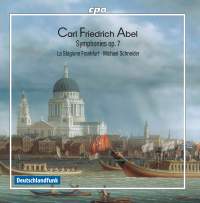Texte paru dans: / Appeared in: |
|
|
Outil de traduction ~ (Très approximatif) |
|
|
Reviewer: Raymond
Tuttle
A few months back, I was in
Jacksonville, Florida on business. As I usually do, if I have any free time
at all, I checked to see if there were any promising used book or music
stores close to my hotel. (I am, after all, a “serious record collector.”)
As luck would have it, I discovered one within easy walking distance from
where I was staying. With my unerring sense of smell, I located a nook in
which the used CDs were shelved, but I found nothing of interest until I
noticed a cardboard box on the floor. Pay dirt! It was filled with music by
lesser-known composers from the 1700s, or earlier—just the sort of thing
that has been piquing my interest lately. The CDs were priced to sell, and a
discount was offered for buying in quantities. So, because I can’t help
myself, I helped myself, and I even returned a day later to help myself some
more. Among that haul were several CDs of music by Carl Friedrich Abel
(1723–1787), performed by conductor Michael Schneider and La Stagione
Frankfurt. I took to them almost immediately, so I was delighted when this
new Abel release was announced by the CPO label’s American distributor,
Naxos of America. These six symphonies, all of them in three movements and following the fast-slow-fast pattern, date from the 1760s. To put that in perspective, at that time Haydn had recently been hired by Prince Paul Esterházy, and Mozart was starting to compose his toddler symphonies. There’s no reason to go overboard and suggest that Abel was revolutionizing the symphony with these six works, or with any of his other symphonies, but they are consistently enjoyable and frequently distinctive. When I write reviews, I sometimes like to single out movements or works that put the music’s best foot forward, in hopes of encouraging wavering listeners. This time around, it’s hard to choose just a few. It is, as the cliché goes, an embarrassment of riches. Even so, I’ll mention Symphony No. 3. The first movement’s second subject highlights delightfully sighing oboes, and the second movement will appeal to cat lovers because its theme has an oddly meowing quality. (To be fair, this probably has more to do with the period instruments than with Abel’s writing for the strings, although who knows? Perhaps Abel was a cat owner.) Symphony No. 2 has a gorgeously dignified Andante, and, on the other end of the spectrum, Symphony No. 5 closes with a Prestissimo that is comically peremptory. I don’t know if Abel drank, but if he did, this seems like the kind of music he would compose after a night in the London pubs. (During this period, the German-born Abel was based in England, and he and Johann Christian Bach jointly established subscription concerts there bearing both of their names.) La Stagione Frankfurt is comprised of two oboes, two horns, three first and three second violins, two violas, two cellos, one double bass, one bassoon, and harpsichord. The fast music is exciting—it sometimes has a vinegary bite, but it isn’t brutal—and the slow music is played with charm and with feeling. Cantilena, conducted by Adrian Shepherd (Chandos), has recorded these symphonies as well. Their performances are more honeyed, and they have been recorded in a warmer acoustic. Cantilena’s readings probably are a safer bet, at least for newcomers, but I find both recordings enjoyable in their different ways. | |
|
Support us financially by purchasing this disc from eiher one of these suppliers. Un achat via l'un ou l'autre des fournisseurs proposés contribue à défrayer les coûts d'exploitation de ce site. |
|
|
|
|
|
Cliquez l'un ou l'autre
bouton pour découvrir bien d'autres critiques de CD |
|




